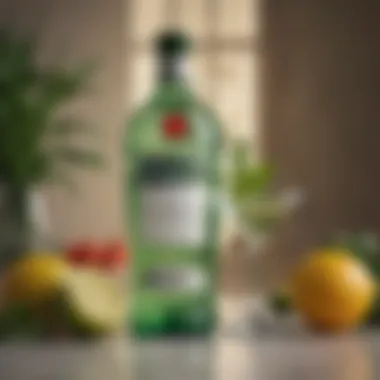Crafting the Perfect Tanqueray Martini: A Guide


Intro
The Tanqueray Martini is more than just a beverage; it is a statement of elegance and craftsmanship. Rooted in history, this cocktail represents a convergence of spirit and skill, appealing to both seasoned cocktail enthusiasts and those new to mixology. With its distinct flavor profile and minimalist ingredients, the Tanqueray Martini stands as a testament to the art of classic cocktail making. This guide will explore the cocktail’s rich history, essential components, and precise methods required for the perfect serve.
Understanding the nuances behind the Tanqueray Martini opens doors to not only better appreciation but also mastery of a timeless drink. It is critical to study various elements — from the provenance of Tanqueray gin to the intricacies of ice methods, garnishes, and variations that have evolved over time.
"The perfect Martini is one that brings balance to the palate."
In embarking on the journey of crafting a Tanqueray Martini, one will benefit from knowledge about the drink's origins, an insight into the relevant ingredients, and a focus on the mixing techniques that highlight the gin’s botanical notes.
The upcoming sections will unfold important aspects of this classic drink, ensuring a thorough understanding for all readers.
Recipe Overview
Recipe Name
Tanqueray Martini
Cuisine Type
Cocktail/Drink
Ingredients
List of Ingredients with Measurements
- 2 1/2 ounces Tanqueray gin
- 1/2 ounce dry vermouth
- Ice cubes (for shaking)
- Olive or lemon twist (for garnish)
Substitutions for Common Ingredients
- For a less dry variant, you can use a splash of sweet vermouth.
- If you prefer simplicity, omit the vermouth altogether for a gin-forward experience.
Prelude to the Tanqueray Martini
The Tanqueray Martini represents a blend of tradition and craftsmanship that has persisted through generations. Understanding this cocktail is not merely about the ingredients; it encompasses history, technique, and culture. This introduction sets the stage for a deeper exploration of the Tanqueray Martini, emphasizing its elegance and appeal. Delving into its background aids not only the novice but also the seasoned cocktail enthusiast in grasping its significance in the world of mixology.
The Origins of Martinis
Martinis have a storied past that captivates cocktail lovers. The very inception of the martini is shrouded in multiple theories. Some attribute its creation to a bartender named Jerry Thomas in the mid-1800s, while others suggest it came from the town of Martinez, California. Regardless of its original birthplace, the martini evolved into a symbol of sophistication over the years.
The classic version is a simple combination of gin and vermouth, but it is adaptable. The inclusion of Tanqueray gin specifically adds a distinct botanical character that never goes unnoticed. The meticulous production process of Tanqueray, which includes the use of four key botanicals, bestows a unique taste that complements this iconic drink.
Why Choose Tanqueray?
Tanqueray stands out among gin brands for several reasons. Its commitment to quality is evident in each bottle. Some points to consider include:
- Heritage: Founded in 1830, Tanqueray has maintained its reputation through tradition and innovation.
- Botanical Selection: The gin is known for its crisp flavor, featuring a balanced profile of juniper, coriander, angelica root, and liquorice. This precise selection enhances the overall martini experience.
- Versatility: Tanqueray's flavor profile allows it to shine both in traditional martinis and modern variations.
The choice of Tanqueray gin is crucial for crafting a martini that highlights refinement. Each sip offers a glimpse into the craftsmanship that goes into creating this spirit, making it a preferred option for martini aficionados.
Ingredients Required
Understanding the ingredients required for crafting a Tanqueray Martini is crucial for both novice and experienced mixologists. The quality and proportions of each component can profoundly influence the overall flavor and presentation of the cocktail. Selecting the right ingredients not only enhances the drink's taste but also reflects the bartender’s skill and knowledge.
Essential Components
The essential components of a Tanqueray Martini include gin, vermouth, and ice. The star of the show is undeniably the gin, with Tanqueray being a favored choice due to its signature balance of botanicals. This specific gin lends a distinct flavor profile—a harmonious blend of herbal notes, which elevate the drink’s character.
Vermouth is the secondary component. It acts as a flavor enhancer rather than disguiser. For a traditional Tanqueray Martini, a dry vermouth is typically used. The amount added can vary depending on personal preference, from a simple rinse of the glass to a more significant pour, showcasing varying degrees of dryness.
Lastly, ice plays an essential role. It not only chills the drink but also dilutes it at a controlled rate. This dilution helps to meld the flavors of the gin and vermouth, creating a more balanced cocktail experience.


Choosing the Right Vermouth
Choosing the right vermouth can significantly impact the drink. Not all vermouths are created equal. When selecting vermouth for a Tanqueray Martini, focus on high-quality brands. Look for unoaked or lightly oaked varieties which allow the botanicals in the gin to shine through. For those who prefer a drier profile, brands like Noilly Prat Dry or Dolin Dry are excellent choices. Remember that freshness of vermouth is paramount. Once opened, it should be stored properly and consumed within a few months to preserve its flavors.
Optional Garnishes
While the classic Tanqueray Martini is often served plain, garnishes can add a distinctive touch. Some popular options include olive, lemon twist, or even aromatic herbs like rosemary or thyme. Each garnish offers a unique sensorial experience, adding slight variations in aroma and taste. The combination chosen should reflect personal preferences but also enhance the cocktail's aesthetic.
A well-chosen garnish not only complements the flavor but also adds a refined finish to the presentation of the cocktail.
Preparation Techniques
Preparation techniques play a vital role in achieving the ideal Tanqueray Martini. Mastering these techniques ensures that the drink not only tastes good but also presents well. A well-prepared martini embodies clarity and refinement, essential components of this classic cocktail. Therefore, understanding the tools, methods, and steps involved in the martini-making process is crucial for both amateurs and seasoned cocktail enthusiasts.
Equipment Needed
Shakers
Shakers are indispensable in cocktail preparation. They facilitate the process of mixing ingredients thoroughly, incorporating air, and chilling the drink efficiently. The most common types of shakers are the Boston shaker and the cobbler shaker. The Boston shaker consists of two separate pieces: a mixing glass and a metal tin. This design allows for flexibility and easier cleanup, which many mixologists prefer. On the other hand, the cobbler shaker features a built-in strainer and cap, making it a popular choice for novice bartenders. Its user-friendly nature simplifies the shaking process while ensuring a smooth pour.
Key characteristics of shakers:
- Mixing efficiency: They are engineered to blend flavors meticulously.
- Chilling: Shaking with ice cools the martini rapidly, enhancing the drink's overall experience.
Advantages of shakers:
- Easily blend flavors and chill promptly.
- Various styles cater to both beginners and pros.
Disadvantages:
- Some may find certain shaker types cumbersome or harder to master, especially the Boston shaker.
Strainers
Strainers are equally important in the preparation of a Tanqueray Martini, ensuring a clean pour without any leftover ice or solid ingredients. The use of a strainer helps maintain the drink's aesthetic and delivers a smooth sipping experience. Julep strainers and Hawthorne strainers are two popular options. The Julep strainer has a flat, rounded scoop design, ideal for cocktails with minimal solids. The Hawthorne strainer, with its spring coil, works best for those drinks that require a more robust filtration process, ensuring no ice shards slip into the glass.
Key characteristics of strainers:
- Filtration: They are designed to separate liquid from solids effectively.
- Versatility: Suitable for various cocktails, keeping your drink style consistent.
Advantages of strainers:
- Allows for a refined drink presentation.
- Prevents dilution from ice shards, preserving taste.
Disadvantages:
- Some strainers may require more cleaning and maintenance than others, like the Hawthorne strainer.
Glassware
Choosing the right glassware is crucial for serving a Tanqueray Martini. A traditional cocktail glass, or martini glass, is typically used. This classic shape not only enhances presentation but also allows for easy sipping. The wide bowl helps retain the martini's aromatic qualities, while the narrow stem prevents heat transfer from hand warmth to the drink.
Key characteristics of glassware:
- Aesthetic appeal: The iconic shape adds elegance to the drink.
- Functionality: Promotes aroma retention and simplifies drinking.
Advantages of glassware:
- Suitable for various cocktails, creating a versatile serving experience.
- Conveys a sense of sophistication, enhancing the drink's overall appeal.
Disadvantages:


- The fragile nature of typical martini glasses can make them prone to breakage.
Step-by-Step Preparation
Preparation of a Tanqueray Martini involves a carefully structured process. Following specific steps helps ensure the balance and flavor that define this cocktail. The sequence typically includes chilling the glass, shaking or stirring the ingredients, and then straining the mixture into the glass. Accurate measurements of gin and vermouth are fundamental for achieving the desired taste profile. Following these precise steps encourages practice and experimentation, leading to a better understanding of the cocktail-making craft.
Serving Suggestions
The presentation of a Tanqueray Martini is as critical as the ingredients and preparation. Serving suggestions enhance the drink’s overall experience. They create an inviting atmosphere and showcase the cocktail's sophistication.
When serving a Tanqueray Martini, the choice of glass is pivotal. The traditional option is the classic martini glass. Its distinctive shape allows for easy sipping while emphasizing the cocktail's clarity. A champagne flute is also an option for a more contemporary twist, giving the drink a modern touch. Some often overlook this detail, but the aesthetics of the glass contribute significantly to the drinking experience.
Moreover, consider the environment. Ambient temperature and settings play an important role in the enjoyment of a cocktail. A well-chilled glass can keep the drink at an ideal temperature longer. This enhances the flavors and allows the botanicals of the Tanqueray gin to shine through.
In addition, garnishes should not be merely an afterthought. They can elevate the overall taste profile of the drink. Common garnishes include olives or a twist of lemon. Use them mindfully. For example, a lemon twist can provide a zesty aroma, enhancing the fragrant botanicals in the gin.
"Presentation and serving are the final acts in the cocktail creation process. They can make or break the drinking experience."
Ideal Glassware Choices
Choosing the right glassware for a Tanqueray Martini is essential to its presentation and enjoyment. The most common is the classic martini glass. It has a wide bowl and narrow stem. This shape allows the aromatic compounds to concentrate while maintaining a cool temperature.
Alternatively, the coupe glass has gained popularity in bars and restaurants. Its round bowl adds a touch of elegance. This glass is also useful for different cocktails, making it versatile. However, it may not retain temperature as well as the martini glass.
Some mixologists also experiment with highball glasses or lowball glasses. While this is less conventional, it can create a casual vibe. It is crucial to maintain the essence of the drink regardless of the glass choice.
Temperature Considerations
Temperature is a critical aspect when serving a Tanqueray Martini. The ideal temperature affects taste and mouthfeel. A martini should be served very cold. This is often achieved through chilling the ingredients and glassware before preparation.
To chill a glass, fill it with ice water and let it sit for a few minutes. Remove the ice water shortly before pouring the martini into it. This ensures minimal dilution and maintains the integrity of the beverage.
Furthermore, the gin itself should be stored in the refrigerator. This keeps it cool and enhances the sipping experience. Taking care of these aspects will yield a martini that is refreshing and crisp at every sip.
Variations of the Tanqueray Martini
Exploring variations of the Tanqueray Martini opens up avenues for creativity and personal preferences in cocktail crafting. Understanding these variations can enrich the drinking experience, allowing individuals to tailor flavors to their liking. Each variation can embody different taste profiles and serve various occasions. With the core elements in mind, one can venture into these adaptations while still respecting the classic roots of the Tanqueray Martini.
The Dirty Martini
The Dirty Martini is a well-known twist that brings a savory edge to the classic recipe. In this version, olive brine is added to impart a recognizable saltiness and depth of flavor. Typically, this includes the same base of Tanqueray gin and vermouth, but the proportion of vermouth is often reduced to make way for the brine. This adjustment is crucial for balancing the flavors. Enjoyment of a Dirty Martini often lies in its garnish, which typically includes green olives.
"The Dirty Martini captures the essence of simplicity while adding a complex twist to the classic flavor."
A common recipe might consist of:
- 2.5 ounces of Tanqueray gin
- 0.5 ounces of dry vermouth
- 0.5 ounces of olive brine
Shake the ingredients with ice and strain into a chilled glass. Experimenting with the olive brine can yield unique flavor notes, enhancing this already diverse cocktail.
The Vesper Martini
The Vesper Martini, made famous by the James Bond character, offers a refined yet distinct approach. This version mixes Tanqueray with vodka, along with Lillet Blanc instead of traditional vermouth. The blend of spirits encapsulates an elegant drinking experience, with a blend of botanical notes from Tanqueray and a crisp finish from vodka.
A classic Vesper recipe features:
- 3 ounces of Tanqueray gin
- 1 ounce of vodka
- 0.5 ounces of Lillet Blanc
The preparation is straightforward: shake the ingredients over ice and strain them into a martini glass. This cocktail is often garnished with a lemon twist, adding a citrus flair that complements the botanical complexity.
Herbal and Floral Infusions


Herbal and floral infusions are experimental variations that cater to those who seek a touch of nature in their cocktails. Utilizing ingredients like basil, thyme, or lavender can transform the standard Tanqueray Martini into a refreshing delight. The key here is to keep the infusion balanced and not overpower the gin's inherent botanicals.
To create a herbal infusion, consider this approach:
- Infuse your Vermouth: Place herbs like basil or thyme in vermouth and let it steep for an hour or so.
- Mix with Tanqueray: Use this infused vermouth instead of standard vermouth in your Martini.
- Garnish: A sprig of the same herb can serve as a garnish, tying the flavors together.
Using floral notes can include adding elderflower liqueur for a slightly sweet touch. Each infusion requires careful measurement to avoid diluting the overall integrity of the drink.
Pairing Food with Tanqueray Martini
Pairing food with a Tanqueray Martini is an art that enhances the entire drinking and dining experience. The choice of food can elevate the cocktail's flavors and aromas while creating a harmonious balance that excites the palate. The crisp and botanical notes of Tanqueray gin provide a versatile backdrop, complementing a range of dishes. In this section, we will explore the key considerations when pairing food with this classic cocktail, focusing particularly on appetizers and main courses.
Appetizers that Complement
When considering appetizers to serve with a Tanqueray Martini, it is important to choose items that do not overpower its delicate flavor profile. Light and refreshing dishes usually work best. Here are some options that align well with this cocktail:
- Oysters: The briny and fresh taste of oysters pairs perfectly with the gin’s herbaceous qualities.
- Cucumber sandwiches: These light bites provide a refreshing contrast to the cocktail's boldness.
- Cheese platter: Soft cheeses, like goat cheese or brie, can create a pleasant texture that enhances the drinking experience.
Serving Tip: Consider presenting appetizers on a stylish platter, which adds visual appeal and can spark conversation among guests.
Main Course Pairings
As for main courses, the selection becomes more diverse, but care should be taken to maintain the integrity of the Tanqueray Martini. Dishes that highlight fresh ingredients are often the best fit. Here are some suggestions:
- Grilled fish: The lightness of fish such as sole or seabass balances the cocktail beautifully.
- Pasta primavera: A dish with seasonal vegetables in light sauce can complement the gin's botanical notes without overwhelming them.
- Roast chicken: A well-seasoned roast chicken with herbs can echo the flavors found in the Tanqueray gin.
By thoughtfully selecting food to accompany a Tanqueray Martini, one can create a consistent and pleasurable culinary journey. This connection between the drink and the dish is essential for any occasion, providing a layer of sophistication that elevates a mere cocktail hour into an unforgettable experience.
Trends and Innovations
Understanding the trends and innovations surrounding the Tanqueray Martini is essential for contextually appreciating its evolving place in modern cocktail culture. These trends indicate a return to classic standards combined with a fresh approach to flavor and presentation. The cocktail scene is replete with both nostalgia and creative experimentation, making it an interesting subject for examination.
Craft Cocktail Movement
The craft cocktail movement has significantly influenced how people experience drinks like the Tanqueray Martini. This trend emphasizes quality ingredients, precise techniques, and artisanal methods to create cocktails. Enthusiasts and professional mixologists alike pay close attention to the origins of ingredients, treating them almost as high-end culinary components.
This shift encourages a more thoughtful approach to mixing drinks. For instance, using fresh herbs or unique flavored vermouth can elevate a Tanqueray Martini beyond the standard recipe. The craft movement also promotes small-batch production and locally-sourced products, which resonate well with contemporary consumers who care about sustainability and supporting local businesses. Therefore, drinks made in line with this movement tend to offer a more distinct, high-quality taste.
Tanqueray in Contemporary Mixology
In contemporary mixology, Tanqueray has secured its reputation as a benchmark for quality gin. The brand continues to evolve its image and product offerings, aligning with current consumer preferences. Innovative takes on the Tanqueray Martini are frequent, with variations that incorporate complementary flavors. Mixologists might experiment with botanically-infused gins or craft their own bitters to create something unique.
Furthermore, the emphasis on visual aesthetics in cocktails aligns with trends in social media, driving bartenders to craft eye-catching presentations. A well-made Tanqueray Martini garnished with a twist of lemon peel or an olive does not only taste good but also looks appealing for sharing on platforms like Instagram or Reddit.
Overall, the integration of artisan methods and a focus on quality ingredients enriches the experience surrounding the Tanqueray Martini. The fluctuations in trends bring fresh ideas while honoring the timeless aspects of this classic drink. This synergy creates innovative drinking experiences that can appeal to both traditionalists and adventurous consumers.
"The resurgence of the Tanqueray Martini within the craft cocktail movement showcases how a classic can adapt and thrive in contemporary settings, attracting a diverse audience."
The mixed culture surrounding the Tanqueray Martini signifies an ongoing appreciation for history and an eagerness to explore new dimensions.
Epilogue
The conclusion serves as a pivotal section that encapsulates the essence of the Tanqueray Martini experience. By summarizing the intricate details explored in this article, it reinforces the appreciation for this classic cocktail. The discussion includes its history, preparation techniques, variations, food pairings, and current trends in mixology. Each of these elements contributes to a richer understanding of what makes the Tanqueray Martini more than just a drink but an art form.
Summarizing the Tanqueray Experience
To truly appreciate the Tanqueray Martini, it is essential to reflect on its layered complexity. The combination of high-quality gin, like Tanqueray, and well-chosen vermouth creates a drink that is both refreshing and sophisticated. This cocktail's longstanding appeal lies in its balance, which can be adjusted based on personal preferences, whether someone prefers a drier or wetter Martini. Through careful measurement of ingredients and skillful mixing, every sip reveals layers of flavor that honor its roots while allowing for modern interpretations.
Moreover, the choice of garnish, whether it be an olive or a twist of lemon, can significantly impact the drinking experience, providing an additional layer of depth. This highlights how the Tanqueray Martini is not just about the drink itself, but also about the ritual of preparing and serving it, making each occasion special.
Encouragement for Experimentation
Encouraging experimentation is crucial in mastering the art of cocktail creation. While the classic Tanqueray Martini deserves respect, mixologists are invited to explore variations that resonate with their own tastes. For instance, trying different vermouth brands can lead to vastly different flavor profiles. Adding spices or infusions can contribute to a unique twist, allowing the cocktail to be adapted for seasonal themes or personal preferences.
The craft cocktail movement thrives on innovation and boundary-pushing, making this a particularly exciting era for cocktail enthusiasts. Utilizing various garnishes or adjusting the gin-to-vermouth ratio opens new avenues of flavor exploration. This spirit of discovery fosters a deeper connection to mixology, transforming the process from mere drink preparation to an engaging culinary journey.
Ultimately, the Tanqueray Martini stands as a canvas for creativity, inviting both novice and experienced mixologists to embrace their instincts and create a drink that is as sophisticated as it is personal.













